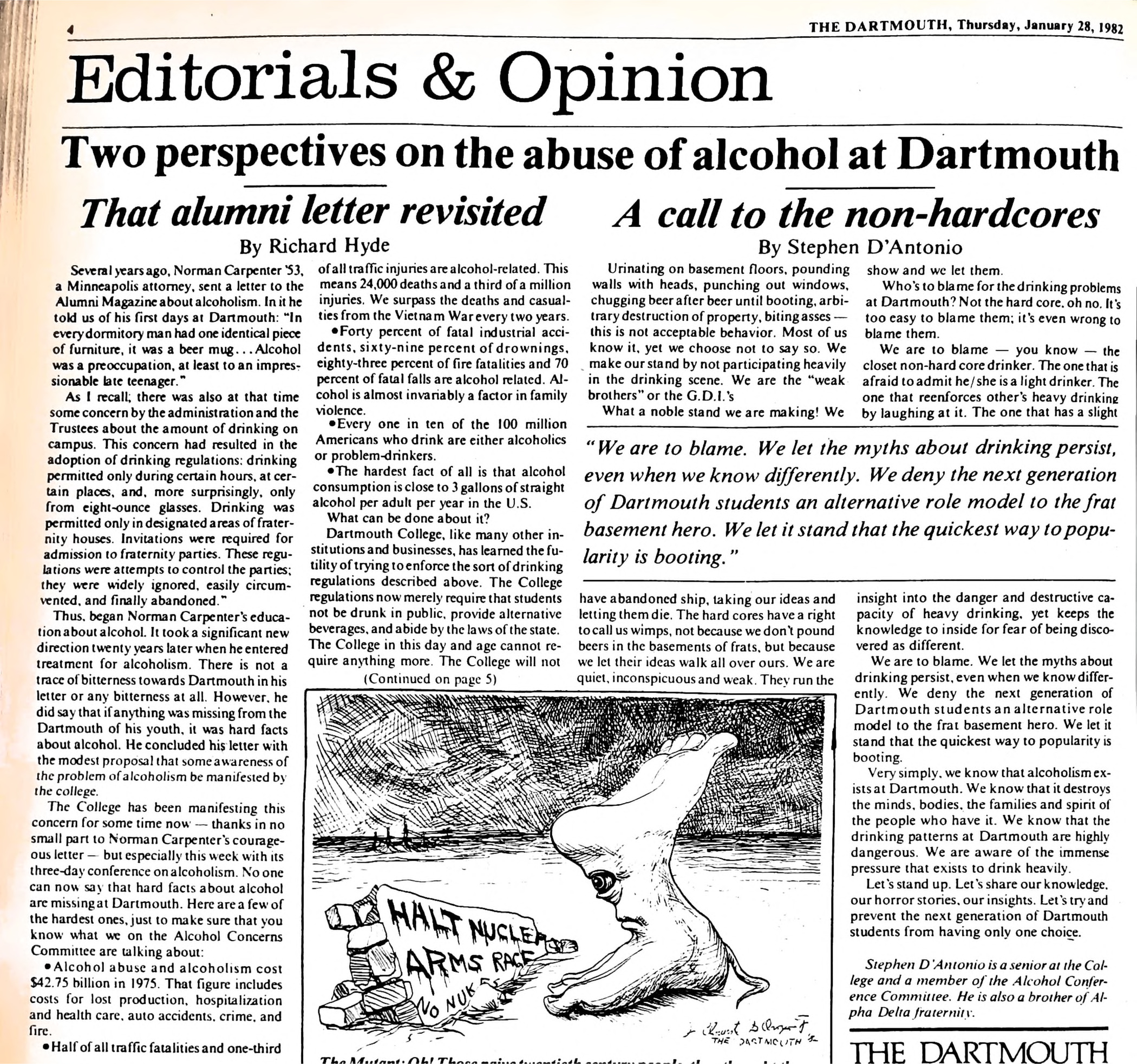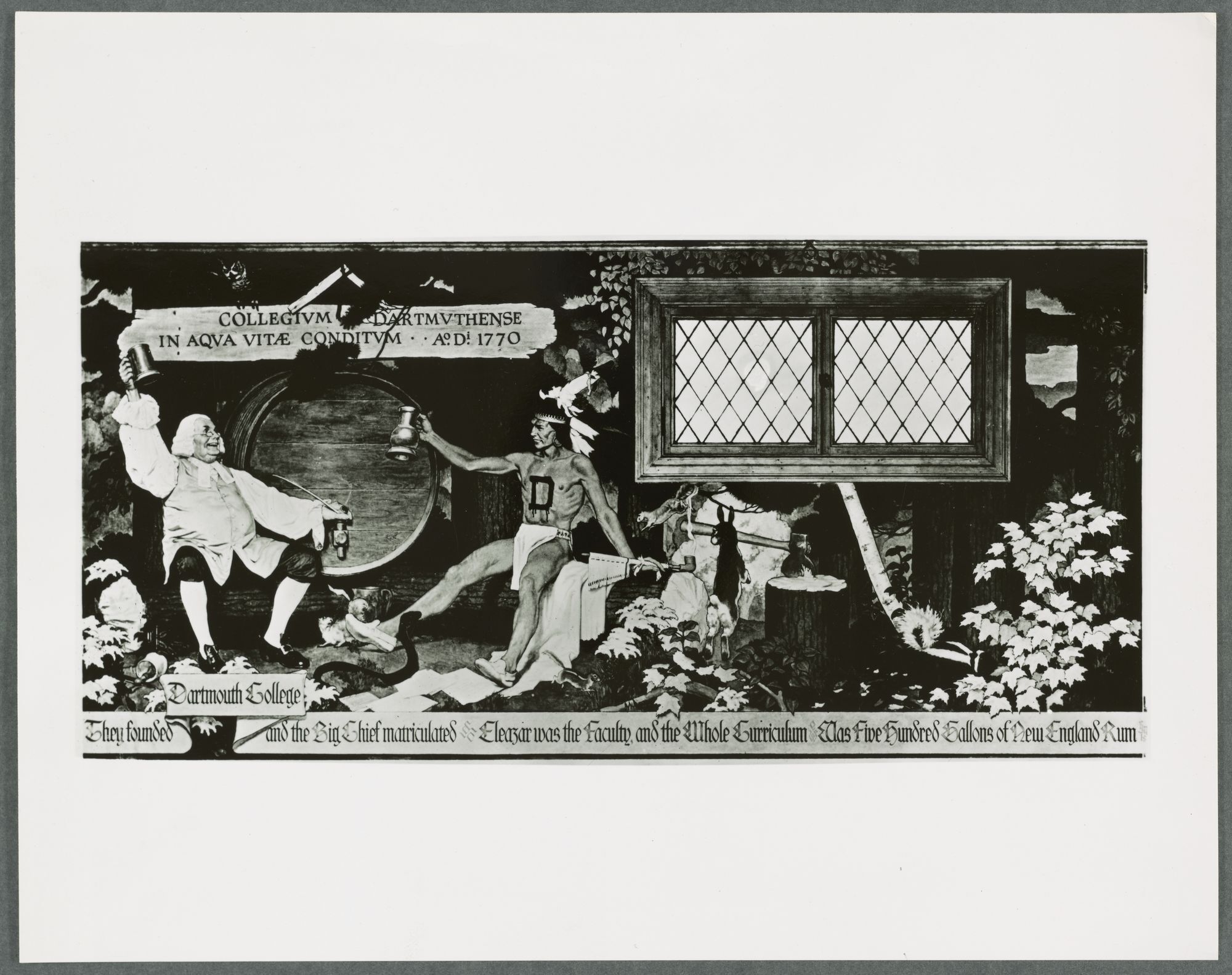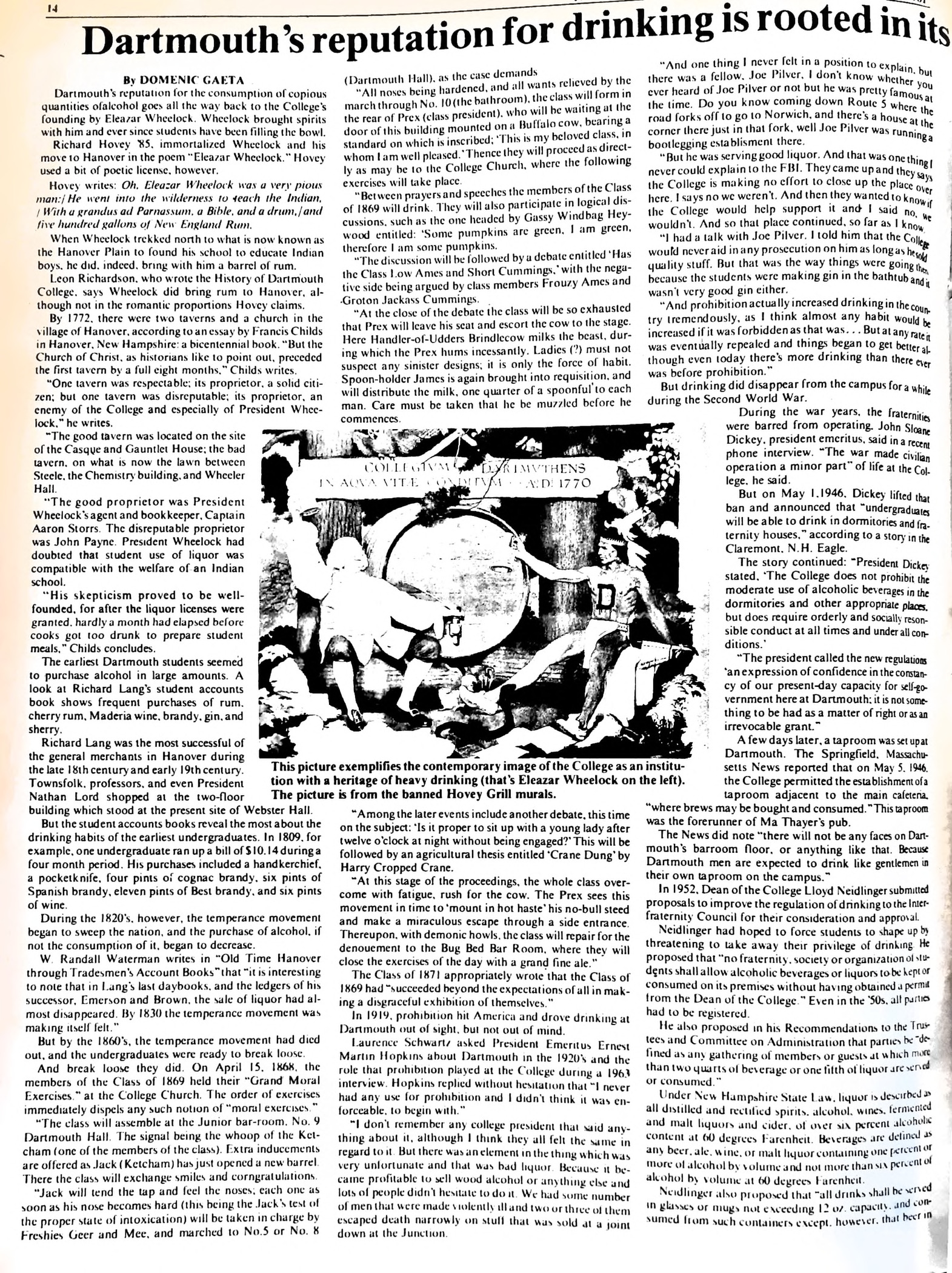Discussions Surrounding Drinking Culture 1976-1983
It wasn’t until 1976 that discussion about the dangers of alcohol abuse reached Dartmouth’s campus by way of a modest, 1-page article published in the Dartmouth Alumni Magazine by alumnus Norman Carpenter ‘53. The contents of this article offer interesting through-lines into understanding what drinking culture would look like in the 1970s.
The general purpose of his writing was to create a sensitivity and awareness to the unique drinking culture at Dartmouth, although Carpenter was careful to admit there was no “hard evidence” to suggest his drinking problem would not have emerged had he gone to a different college, He wrote that “the strong impression on an immature underclassmen was that acceptance on campus depended upon the ability to imbibe ethyl alcohol. Even among the less impressionable it must have seemed that drinking was integral to the social process, more especially at Dartmouth than at similar colleges.” Writing back to the campus he had graduated twenty years prior, Carpenter said that he was unaware if the situation had changed with respect to drinking. However, the impetus for his writing was a bulletin sent to alumni in 1975 which “indicated that drinking is an integral part of Commencement and Reunions.” As such, it seems that Dartmouth’s drinking culture extended past the bounds of Hanover, working on Carpenter decades later to the degree he had to take action.
He wrote that Dartmouth gained notoriety within programs that treated alcoholics, as he anecdotally encountered an inordinate number of Dartmouth men and wives in treatment. Although not referenced directly by Carpenter, it’s important to understand that one of the founders of Alcoholics Anonymous (A.A.) is also an alumnus of Dartmouth: Dr. Bob Smith graduated in the class of 1902, and in the A.A. core text, Dr. Smith wrote of Dartmouth as “one of the best colleges in the country where drinking seemed to be a major extracurricular activity.”[1] Despite their time on campus being separated by over half a century, both Dr. Bob and Carpenter note that popularity was contingent on who “could drink the most without throwing up.”[2]
Parts of Carpenter’s letter point to aspects of Dartmouth drinking mythology that must be continually remembered. When published in the alumni magazine, Carpenter’s letter appeared under the title “Fill the Bowl Up?,” a reference that would have been instantly understood as a nod to alumnus Richard Hovey’s song Eleazar Wheelock which embellished the mythical founding of Dartmouth by Wheelock:
Eleazar Wheelock
Oh, Eleazar Wheelock was a
very pious man; He went into the
wilderness to teach the Indian,
With a gradus ad Parnassum, a Bible, and a drum,
And five hundred gallons of New England rum.
Fill the bowl up!
Fill the bowl up! Drink to Eleazar
And his primitive Alcazar
Where he mixed drinks for the heathen,
In the goodness of his soul.
In the 1970s, this poem would have been recognized as a common song sung by acapella groups on campus. In 1938, the Board of Trustees commissioned a mural to depict the founding of Dartmouth using Hovey’s drinking song as inspiration. Painted on the walls of a basement dining room in Thayer Hall, the Hovey Murals perpetuated the exaggerated narrative of Wheelock’s New England Rum while caricaturing Native Americans. In the 1970s, with the creation of the Native American program and introduction of women with coeducation, the Hovey mural room was cleared out and locked to the public.
After Carpenter’s letter landed in the alumni magazine, the Dartmouth community latched onto his testimony. In the same way that the Hovey murals served for decades as active remembrance of Dartmouth's specific drinking mythology, Carpenter’s story extended into the next Alumni Magazine issue through letters from other alumni that related to Carpenter’s story. His article was reprinted in The Dartmouth under the title “No son-of-a-gun for beer,” which again takes the lyrics of a popular campus drinking song to establish Carpenter’s article in conversation with contemporary drinking culture on campus.
Perhaps the last important event to mention was the release of Chris Miller’s National Lampoon’s Animal House in 1978. Written by alumnus Chris Miller ‘63, Animal House was believed to harken back to Miller’s experienced in Alpha Delta at Dartmouth. The film detailed a rambunctious fraternity’s troubled relationship with school administrators. Scenes in the movie painted the fraternity system and it’s constituents as racist, sexist, homophic, and deeply dependent on alcohol. Animal House was frequently referenced in national coverage of Dartmouth Greek life during this time.
In the 1970s, after the admittance of women to the college, fraternity life was examined with a new lens. Questions about what the fraternity system should look like at Dartmouth related to alcohol use as well as behavioral patterns that tended towards sexism, racism, and homophobia.
[1] Alcoholics Anonymous, “Bill’s Story,” The Big Book, 2001, https://www.aa.org/the-big-book.
[2] Goldberg, David. “Letter from concerned alumnus inspires alcohol conference.” The Dartmouth (Hanover, NH), January 29, 1982, Rauner Special Collections Library, Hanover, NH.
From the Archives
Click on an image to access the full document, audio-visual components, and/or metadata associated with that item.

Opinion article written by Matthew Joyner '81 on drinking culture and exclusivity perpetuated by the fraternity system in 1979.

Two articles published in The Dartmouth Opinion section in 1982. In "That Alumni Letter Revisted," Richard Hyde used Norman Carpenter's story to spread awareness about alcohol abuse. In "A Call to the Non-Hardcores," Stephen D'Antonio '82 advocated for light-drinkers to assert more presence on campus.
 Historical Accountability Student Research Program
Historical Accountability Student Research Program


